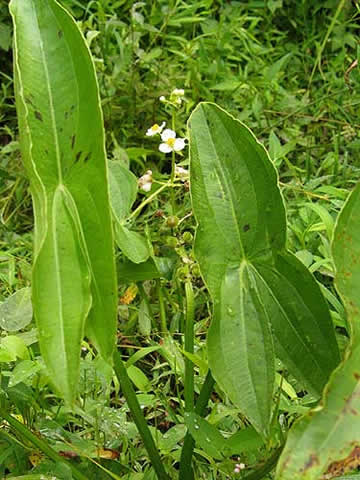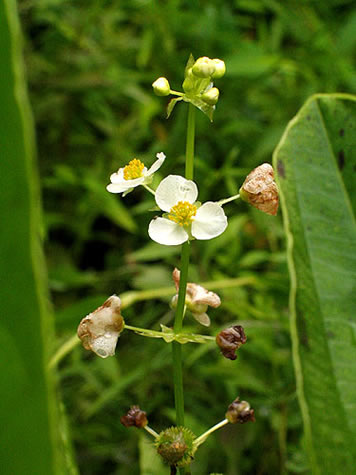Description: Perennial from tuber-producing (egg-shaped) rhizomes; plant to 3 feet tall. Leaves are all basal, with long stalks, leaf blades arrowhead-shaped, to 25 cm long; submerged leaves lance-shaped or even bladeless and linear. Flowers white, 1-2 cm across, often unisexual flowers; 3 greenish sepals, 3 petals, falling off early, ovaries and stamens numerous in several whorls of 3 in a long, terminal cluster. Fruits sharp-beaked, flattened, winged achenes that are numerous in a globular cluster.
Habitat: Marshes, ponds, lakes, wet ditches; usually emergent but often partly submerged; low elevations.
Use: Often First Peoples claimed wapato patches by clearing the area of competing growth to gain access to the tubers. Harvesting usually occurred in October and November. Since the tubers lay under water, the work was done by canoe, pulling the roots from a kneeling position, or as an alternative, by wading in the water and dislodging the tubers with the toes. Wapato tubers kept for several months if left unwashed in the raw state. They were stored and cooked as needed by baking in hot ashes. The tubers provide an excellent source of carbohydrate. The journals of Lewis and Clark relate that their diet while traveling in Oregon was elk meat and wapato bulbs, purchased from the Indians. The wapato resembles the potato in texture, but has a sweeter taste.

From Plants for a Future
Root - raw or cooked. Excellent when roasted, the texture is somewhat like potatoes with a taste like sweet chestnuts. The tubers can be eaten raw but they are rather bitter (especially the skin). It is best to remove this skin after the tubers have been cooked. The tubers can also be dried and ground into a powder, this powder can be used as a gruel or mixed with cereal flours and used to make bread. The N. American Indians would slice the boiled roots into thin sections and then string them on ropes to dry in much the same way as apples.The egg-shaped tubers are 4 - 5cm long and are borne on the ends of slender roots, often 30cm deep in the soil and some distance from the parent plant. The tubers are best harvested in the late summer as the leaves die down. They cannot be harvested by pulling out the plant since the tops break off easily, leaving the tubers in the ground.
 Common Arrowhead
Common Arrowhead